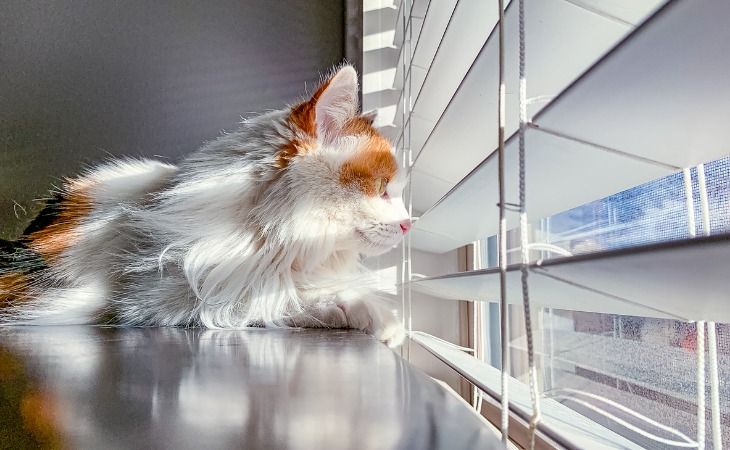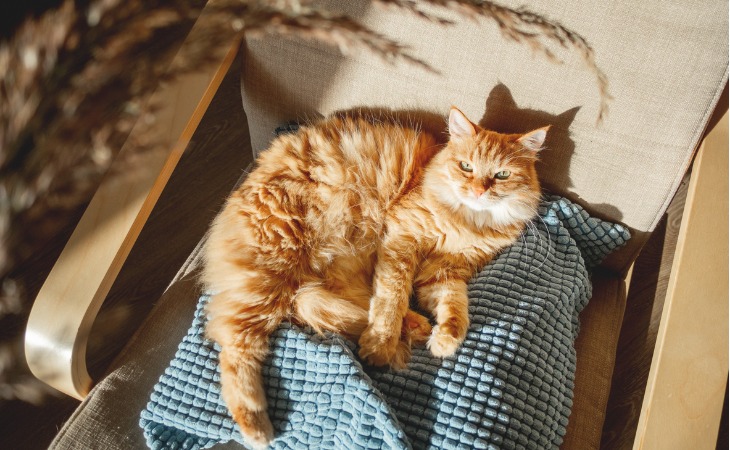When the sunny days start to come and the temperatures start to rise, it’s important to protect your cat from the heat. Our cat friends are very sensitive, so it best to take certain precautions.
Cats can only tolerate up to a few degrees more than humans since their body temperature is already higher. However, cats do not sweat, except for on their paw pads. Cats pant in order to regulate their body temperature and keep it stabilized.
Here are our tips for protecting your cat from the heat.
Helping your cat cool down in the heat
The solutions to keep your cat cool are quite similar to how humans keep themselves cool when it’s hot out. These tips can be used for all animals in the house.
Keep rooms at a low temperature
During the day, curtains and blinds can be kept closed to keep rooms from getting too hot. Your cat will be able to sleep more comfortably and avoid overexertion, which would generate extra heat.
Ventilating the rooms can be a solution. If you use an air conditioner or a fan, use a low setting and rotating setting if possible. Also, make sure that it is not too close to where your pet sleeps.
Keep your cat hydrated
Water bowls can be placed in several locations around the house and changed regularly to stay cool throughout the day. To protect your cat from getting too hot, you can put ice cubes in your cat’s water bowls for added coolness. You can also feed your cat wet cat food to keep them hydrated.
Another useful tip to keep your cat cool is to freeze bottles of water and put them out for your cat to rub and lick off the condensed water. Be careful, however, not to cause too sudden a change in temperature.
Brush your cat’s fur
Shortening your cat’s fur a little can help them manage the heat much better. Brushing your cat regularly can also help allow your cat to regulate their body heat more easily. This will also prevent your cat from ingesting too much of their hair because cats groom themselves more frequently during hot weather.
Choose a suitable outdoor time
If your cat is used to going outside and spends their days hunting in your garden, it is best to control their comings and goings on very hot days.
Humans are advised to avoid going outside during the hottest hours, which are between 11 a.m. and 2 p.m. To keep your cat from getting too hot, the same rule applies to them. Cats can withstand temperatures over 40°C (104°F) degrees, but can quickly find themselves in a bind and in danger if they stray too far from their home to seek shelter.
Protecting your cat from the heat: adapt their diet if necessary
If your cat is overweight, it is possible that a lighter diet will be beneficial during periods of intense heat. Overweight cats have a harder time handling the heat.
Changing your cat’s diet in the spring to prepare for the summer can be a solution so that they do not have to face this situation during hot weather.

Sun exposure
It is not uncommon for a cat to bask in the sun. Cats truly enjoy sunbathing when it isn’t too hot outside. However, their sun exposure must be controlled to avoid any issues with their skin. It’s also important to note that some cats are more sensitive to the sun than others.
Sunbathing
Cats love to lie in front of windows, rest on balconies and in the garden. Sometimes they wriggle around and rub themselves on the floor when it is warm. Cats enjoy lying out in the sun when the temperatures and not too high and they do not hesitate to show their appreciation! Luckily, their coat protects them from U.V. rays. With that being said, be careful not to prolong their exposure because it’s still possible for cats to get sunburns.
Decreased body temperature
When a cat falls asleep, its body temperature naturally drops. When this happens, cats will often look for a source of heat so that they can bask in it and warm up. This is also why they are usually found near or on heaters in the winter. Any source of heat is acceptable! Cats will also often sleep in a ball to keep themselves warm. They will avoid as much as possible areas where there are draughts.
Some cats have health issues that can cause a drop in their body temperature. When they are feeling cold, they will seek warmth from their owner, look for warm and comfortable places to nap, and of course hang out under the sun.
Sunburn
Despite their fur, it’s possible for cats to have too much exposure to the sun.
How do I know if my cat is sunburned?
When cats are exposed to the sun for a long time, it’s possible for them to get a sunburn. However, it is not so obvious that it’s easy to notice it immediately. When cats have a sunburn, their skin is reddened but it is difficult to see through a dense coat.
However, you can tell if your cat is sunburned by looking at their nose and ears. These are two areas that will be most sensitive to touch. If your cat reacts, it may be because they are sunburned.
If there is hair loss on certain areas of the cat’s body and it is accompanied by redness, this is most likely a sign that your cat has been affected. Skin depigmentation and redness on their body after exposure are not deceiving. It is important to act quickly when you notice that your cat is sunburned to relieve it.
Treating sunburn
Water compresses can help relieve them and cool their wounds. The best option is to consult a veterinarian quickly. They will be able to evaluate the burns and let you know what needs to be done to relieve their pain. Quick treatment is recommended to rule out any risk of skin cancer.
Avoid heat exposure until healed
After a sunburn, make sure that your cat is not exposed to heat until the wounds have completely healed. Overexposure could aggravate the damage that has already been caused.
Sensitive cats
Cats with lighter coats and Sphynxes, with their very fine down, are the most likely to get sunburned. They are more sensitive than other cats. If your cat is under a certain treatment, be aware of the side effects. Some medication requires cats to stay away fromthe sun, just as they do for humans.
While not many people know about it, protective creams for animals exist. They allow us to protect our pets without forcing them to stay inside when it is hot outside.
Heat stroke
In case of heat stroke, it’s important to consult a veterinarian. This is because the situation can become worse within just a few minutes. If your cat starts panting and breathing heavily, they are trying to ventilate itself as best as possible.
Your cat may start to salivate and show signs of severe weakness. If you notice this, your cat must be taken away as soon as possible to be treated and rehydrated quickly.
The effects of heat should not be taken lightly, especially when it comes to the health of our most faithful companions. By following these tips to protect your cat from the heat, your cat will be safe from the dangers of hot temperatures.

